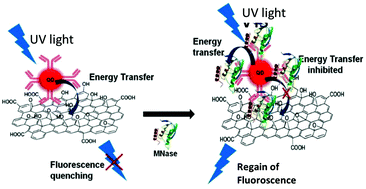An “OFF–ON” quantum dot–graphene oxide bioprobe for sensitive detection of micrococcal nuclease of Staphylococcus aureus†
Abstract
Micrococcal nuclease (MNase) is an extracellular endonuclease of Staphylococcus aureus (S. aureus). It digests single stranded nucleic acid. The presence of MNase is the gold standard to identify S. aureus and its content. The present study reports the ultrahigh sensitive and selective fluorescence platform for MNase detection, designed and developed based on the surface energy transfer mechanism. A “proof of concept” is being developed based on monoclonal antibody-conjugated quantum dots (mAb-QDs), wherein mAb-QDs act as donors and graphene oxide (GO) acts as an acceptor. mAb-QDs in close proximity to GO undergo adsorption due to weak affinity between them and this results in fluorescence quenching by the transfer of surface energy from mAb-QDs to GO. During sensing, a much stronger affinity of mAb-QDs towards MNase inhibits the energy transfer to GO and this allows the regaining of fluorescence. Immobilized mAb-QDs on nitrocellulose membrane strips were fabricated and tested for “ON–OFF–ON” sensing of MNase. The limit of detection for fluorescence based assay and strips is found to be 0.3 ng mL−1 and 0.5 ng mL−1, respectively. The developed strips were applied on real samples for the detection of S. aureus.



 Please wait while we load your content...
Please wait while we load your content...